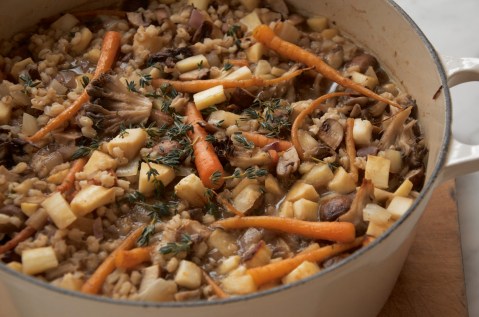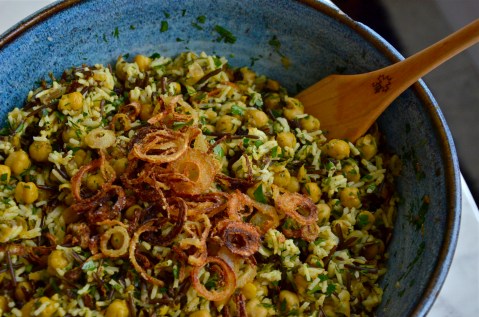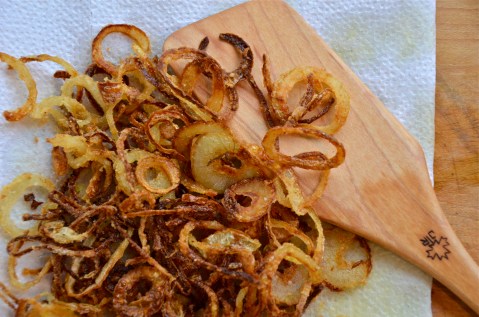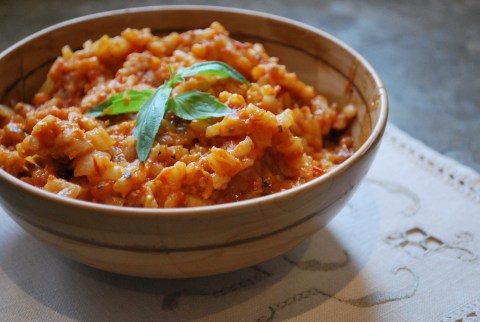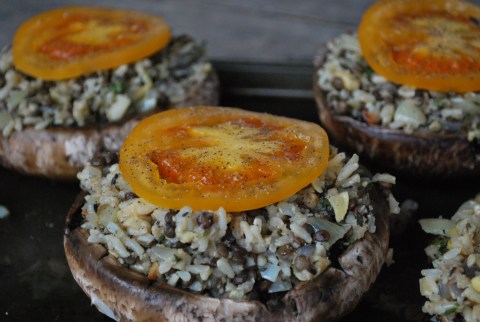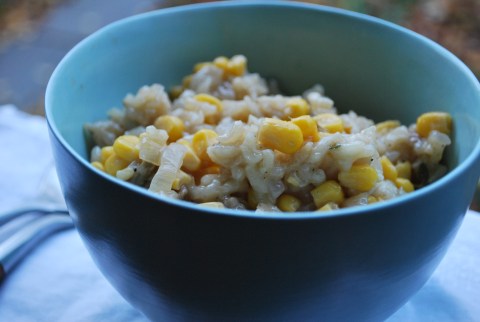walnut red pepper tabbouleh
February 16, 2015
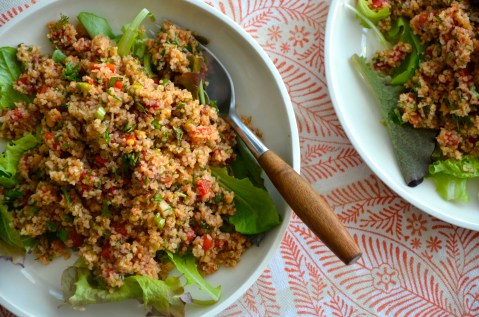
Making wheat into bulghur is an ancient process that originated in the Mediterranean region and has been an integral part of Middle Eastern cuisine for thousands of years. They say that in approximately 2,800 B.C., the Chinese emperor Shen Nung declared it one of five sacred crops along with rice, millet, barley and soybeans, and historical references indicate it was prepared by ancient Babylonians, Hittites and Hebrew populations some 4,000 years ago. The Roman word for it was cerealis; Israelites called it dagan. Other Middle Easterners called it arisah. And it’s been variously know as burghul, burghoul, balgour and boulgur. By any name you call it, it’s a solid, nutritious base for this walnut-red-pepper-type-tabbouleh with hints of smoky paprika and the always welcome freshness of herbs like dill, mint and parsley.
1 cup medium-course bulghur
2 cups water
6 spring onions, chopped
4 garlic cloves, roasted or raw, minced finely
3 red peppers, roasted, seeded, skinned, and diced
1 tsp smoked paprika
2 tbsps tomato paste
4 tbsps olive oil
1 cup walnuts, toasted, chopped finely
3 tbsps roughly chopped parsley
2 tbsps roughly chopped mint
1 tbsp roughly chopped dill
sea salt and pepper to taste
Place bulghur and water in a pot and place on high heat. Once water comes to a boil, turn heat down and let simmer until bulghur is cooked. Drain if necessary and place cooked bulghur in a bowl. Add the remaining ingredients, mix well and season.
Adapted from Casa Moro by Sam and Sam Clark
mushroom barley stew with stout
January 12, 2014
Every January I post a mushroom recipe. Last year it was the fabulous and savoury mushroom tart. The year before that it was the creamy triple mushroom gemelli, not to be missed. The year before that, the comforting winter portobello stew. This year I’m featuring mushroom barley stew with stout – a recipe I’ve adapted from Rich Landau and Kate Jacoby’s vedge cookbook, named after their restaurant in Philadelphia. Not only is this stew thick and warming and richly flavoured with beer, mushroom stock, thyme and worcestershire sauce, but it’s inspired by chefs whose philosophy I love. Rich and Kate call vedge a vegetable restaurant, “not a vegetarian or vegan one, and only once you eat there do you truly understand that distinction. Rich’s dishes are jubilant celebrations of vegetables, not an attempt to accommodate a so-called dietary restriction.” This statement almost calls for a trip to Philly just to give Rich and Kate a high-five.
1 cup pearl barley, rinsed and drained
2 cups cubed parsnips
1 cup cubed celeriac
a handful of the babiest of baby carrots (or cubed carrots if you can’t find baby carrots)
1 pound mushrooms, hedgehog if you can find them, chopped
1 cup finely chopped onions
1 tbsp minced garlic
2 tsps sea salt
1 tsp freshly ground black pepper
2 tbsps olive oil
6 cups mushroom stock
1/2 cup stout or dark beer
2 tsps chopped fresh thyme
1 tsp vegan worcestershire sauce
2 tsps chopped fresh parsley
Heat 3 cups water in a large saucepan over high heat. When it comes to a boil, add the barley, reduce the heat to medium, and cook until all of the liquid if absorbed, about 40 minutes. Remove the pan from the heat and set aside to cool for at least 20 minutes.
Preheat oven to 450 degrees. In a large bowl, combine the parsnips, celeriac, carrots, mushrooms, onions, garlic, sea salt, pepper, and olive oil. Toss to distribute the oil, then spread the vegetables on a sheet pan in a single layer and roast until the vegetables start to caramelize at the edges, about 15 minutes.
Meanwhile, combine the stock, beer, cooked barley, thyme, and vegan worcestershire sauce in a large dutch oven and bring to a boil over high heat. Reduce the heat to a simmer.
When the roasted vegetables are done, carefully transfer the roasted vegetables to the stock. Add parsley, adjust seasoning, and serve immediately with some nice crusty bread and a pint of your favourite beer.
mejadra with garlic cucumber salad
July 4, 2013
We had dinner with our friends Colette and David the other night and they made this awesome mejadra. It’s from Ottolenghi (who else?) and I’ve been wanting to try it forever but have just never gotten around to it. So, with a kick in the pants from our dear friends, and Ottolenghi’s cookbook always at the ready, I whipped this up for dinner last night and it was fabulous, especially with a side of Ottolenghi’s cucumber salad. For those of you wondering, mejadra, also know as Mujaddara, moujadara, mudardara, and megadarra is a dish of cooked lentils together with rice and garnished with sautéed onions. Mujaddara is the Arabic word for smallpox because of the look of the the lentils among the rice. The first recorded recipe for mujaddara appears in Kitab al-Tabikh, a cookbook compiled in 1226 by al-Baghdadi in Iraq. Because of its importance in the Arabic diet, a saying in the Eastern Arab world is, “A hungry man would be willing to sell his soul for a dish of mujaddara.” It’s almost that good.
Mejadera
1 cup sunflower oil
4 medium onions, thinly sliced
1 1/2 cups green or brown lentils
2 tsps cumin seed
1½ tbsp coriander seeds
1 cup basmati rice
2 tbsps olive oil
½ tsp ground turmeric
1½ tsp ground allspice
1½ tsp ground cinnamon
1 tsp sugar
Salt and black pepper
2 cups water
Heat the sunflower oil in a medium-size heavy-based saucepan. When very hot, carefully add a third of the sliced onion. Fry for five to seven minutes, stirring occasionally with a slotted spoon, until the onion takes on a nice, golden-brown colour and turns crispy. Use the spoon to transfer the onion to a colander and sprinkle with salt. Repeat with two more batches of onion.
Meanwhile, put the lentils in a small saucepan, cover with plenty of water, bring to a boil and cook for 12-15 minutes, or until the lentils have softened but still have a little bite. Drain into a colander.
Wipe clean the saucepan in which you fried the onion and drop in the cumin and coriander seeds. Place over a medium heat and toast the seeds for a minute or two, until they release those distinctive aromas. Add the rice, olive oil, turmeric, allspice, cinnamon, sugar, half a teaspoon of salt and plenty of black pepper. Stir to coat the rice with oil, then add the cooked lentils and water. Bring to a boil, cover and simmer on very low heat for 15 minutes.
Remove from the heat, lift off the lid and cover the pan with a clean tea towel. Seal tightly with the lid and set aside for 10 minutes. Finally, tip the rice and lentils into a large mixing bowl. Add half the fried onion and stir gently with a fork. Pile up in a shallow serving bowl and top with the rest of the onion.
basmati and wild rice with chickpeas, currants, and herbs
December 9, 2012
I’m not sure why the title of this recipe doesn’t include crispy onions because they are the star attraction. The recipe is from Ottolenghi’s new cookbook that he co-authored with Sami Tamimi called Jerusalem – a must-have for any kitchen or coffee table for it’s inspiring recipes, cultural narrative, and sub-text of love, understanding, and global peace. The authors note it as a sephari-inspired dish that can stand as its own centrepiece or accompany other things like chicken or fish if you eat them. Me? I’ll take it straight up with a double dose of onions which I had to protect under armed guard to keep the marauding hordes away. They are just too tasty to resist.
1/3 cup wild rice
2 cups basmati rice
2 tbsps olive oil
2 tsp cumin seeds
1½ tsp curry powder
2 cups cooked chickpeas cooked and drained\
3/4 cup sunflower oil
1 medium onion, peeled and thinly sliced
½ tbsp plain flour
2/3 cups currants
2 tbsps chopped parsley
1 tbsp chopped coriander
1 tbsp chopped dill
sea salt and black pepper
Cook the wild rice in a small saucepan until cooked but still quite firm. Drain and set aside.
Cook the basmati rice. Remove from the heat, lift off the lid, cover the pot with a tea towel, then put the lid on top and leave to rest for 10 minutes.
Meanwhile, prepare the chickpeas. Heat the olive oil in a small saucepan. Add the cumin and curry powder, and after a couple of seconds add the chickpeas and a quarter-teaspoon of salt; act fast, or the spices may burn. Stir for a minute or two, just to heat the chickpeas, then transfer to a large mixing bowl.
Wipe the pan clean, add the sunflower oil and place on a high heat. Once the oil is hot, mix the onion and flour with your hands. Take some of the mix and carefully place in the oil. Fry for two or three minutes, until golden-brown, transfer to kitchen paper and sprinkle with salt. Repeat in batches until all the onion is fried.
Finally, add both types of rice to the chickpea bowl, along with the currants, herbs and fried onion. Stir and season to taste. Serve warm or at room temperature.
vegetable paella
February 18, 2012
Many of you will have heard of paella. For those of you who haven’t, paella is a Valencian rice dish that originated in Valencia, on the east coast of Spain. Many non-Spaniards view paella as Spain’s national dish, but most Spaniards consider it to be a regional Valencian dish. And, Valencians think of paella as one of those things that make them who they are. There are three widely known types of paella: paella valenciana, paella de mariscoa, paella mixta. But there are many others – all of them free-style combinations of calasparra or bomba rices, wine, saffron and olive oil, green vegetables, beans, and seasoning. It’s a one pan dish full of flavour, texture, and satisfaction. Read on for the recipe below. Or check out v:gourmet’s first (of many) videos above produced by my main man Frantz who’s a student currently at Humber College. Frantz rocks. So does this recipe.
3 tbsps olive oil
1/2 spanish onion, finely chopped
2 cloves garlic, minced
1 small red bell pepper, cut into strips
1 small yellow bell pepper, cut into strips
1/2 fennel bulb, cut into strips
2 bay leaves
1/4 tsp smoked paprika
1/2 tsp ground turmeric
1/4 tsp cayenne pepper
1 cup calaspara rice (or another short-grain paella rice)
6 1/2 tbsps good quality sherry
2 cups veggie stock, heated
sea salt and pepper
3/4 cup shelled fava beans, peas or other green vegetable, cooked
4 tomatoes, cut into wedges
15 pitted kalamata olives
2 tbsps roughly chopped parsley
4 lemon wedges
Heat up the olive oil in a paella pan or large shallow skillet, and gently fry the onion for 5 minutes. Add the bell peppers and fennel and continue to fry on medium heat for about 6 minutes, or until soft and golden. Add the garlic and cook for 1 minute more.
Add the bay leaves, paprika, turmeric, and cayenne to the vegetables and stir well. Then add the rice and stir thoroughly for 2 minutes before adding the sherry and saffron. Boil down for a minute, then add the stock and 1/3 tsp sea salt. Reduce the heat to the minimum and simmer very gently for about 20 minutes, or until most of the liquid has been absorbed by the rice. Do not cover the pan and don’t stir during the cooking.
Remove the paella pan from the heat. Taste and add more salt if needed but without stirring the rice and vegetables much. Scatter the tomatoes, and peas or beans over the rice and cover the pan tightly with a lid or foil. Leave to rest for 10 minutes.
Take off the foil. Scatter the olives on top of the paella and sprinkle with parsley. Serve with wedges of lemons.
mushroom barley ragout
October 2, 2011
Yesterday, Fall and I met for the first time of the season at the back door. I went out to take out the garbage and there she was – crisp cool air, red and orange leaves dancing about in the wind, low saturated light. I had been wanting to try this recipe from Ottolenghi’s Plenty and decided that in honour of Fall’s arrival, I would make it for lunch. Barley is such a warming grain, hearty and comforting. And its the perfect companion to mushrooms and wine in this rich ragout that I have a feeling will take us through to spring. Serve it beside a piece of toasted baguette or hearty sourdough bread for a quick, easy lunch or super.
1/2 cup pearl barley
3/4 oz dried porcini
3/4 cup hot water
4 cups mixed shiitake and button mushrooms, cleaned and halved
2 tbsp olive oil
1 garlic clove, crushed
2 sprigs fresh thyme
1/2 cup white wine
2 tbsp chopped parsley, plus extra
Salt and black pepper
Simmer the barley in plenty of water for 50-70 minutes, until tender but with a bite. Drain and set aside.
Put the porcini in a bowl with the hot water. Put the fresh mushrooms in a hot pan with the oil, garlic and thyme, and sauté, stirring occasionally, for four minutes. Add the wine and let it bubble away for five minutes, then add the porcini and soaking liquid, season, and simmer for 10 minutes. Stir in the parsley and barley. Season to taste.
Serve over some flatbread, toasted baguette or just straight up in a nice big soup bowl.
risotto rosso
January 24, 2011
I’m reading A Tuscan in the Kitchen by Pino Luongo whose description of making risotto comes in handy when you are at the stove and feeling rushed or wanting to cut corners. He says “When you make a risotto you should be in perfect harmony with yourself. You shouldn’t be nervous or angry. It’s a ritual that is going to give you so much pleasure later that it’s worth spending the fifteen or twenty minutes over a hot stove stirring very slowly. It can be like seducing a woman. She doesn’t know you, and you need to work things out with her slowly – meeting, flirting, getting to know each other, and wanting each other. It’s a dish of romance. If you rush it’s never good.” So take your time with this one and enjoy the fruits of your labour. You won’t be sorry.
olive oil
2 large onions, diced
4 cloves garlic, minced
2 cups arborio rice
4 cups pureed tomatoes
1 1/2 cups white wine
big bunch of fresh basil, chopped
salt and pepper
Heat a couple of big glugs of olive oil in the bottom of a heavy saucepan. Add chopped onion and saute until translucent and soft. Add garlic, saute for another minute or two. Then add arborio rice and saute with onions and garlic for about 2 -3 minutes until rice is coated in oil.
Meanwhile, heat tomatoes and wine in a saucepan so they are hot and ready to be added to the risotto. There are a couple of important things to remember when making risotto: a) make sure your liquid ingredients are simmering away so they are hot when you add them, b) add the liquid slowly (just barely cover the rice each time you add the liquid and allow it to be fully absorbed before adding more), and c) stir a lot. So now with these tips in hand, add the tomato/wine mixture slowly and stir lots.
Once you’ve flirted and romanced the rice with the tomato and wine mixture (if you need more than what’s called for above, simply add a bit more wine, tomatoes, water, or stock) and it’s reached the perfect state of al dente-ness, add salt and pepper to taste and the chopped basil. Simple? Totally simple. Totally worth it. Totally perfect.
fennel leek and parsley risotto
January 2, 2011
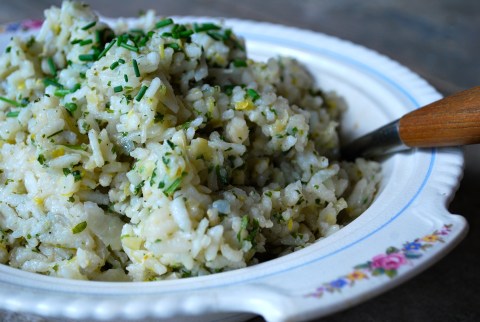
After a season of debauchery with the inevitable over-eating of heavy Christmas dishes we needed something fresh and green to start the New Year. Now most of you will probably not think of risotto as a nice, light, cleansing dish but this one comes pretty close. It’s bright, refreshing, and alive, and without the cheese and butter – which I’ve come to conclude is yummy but totally unnecessary – it is surprisingly light. This risotto won my heart.
2 tbsp olive oil
1 onion, diced
1 fennel bulb, diced
2 leeks, diced
3 cloves of garlic, minced
1.5 cups of arborio rice
4 cups of veggie stock
1 cup white wine
a small bunch of fresh parsley, very finely chopped
1/2 lemon
sea salt and pepper to taste
Heat the olive oil for the risotto in a heavy-bottomed dutch oven. Saute onion, fennel, and leek until tender. Add the minced garlic and saute another minute or two until the garlic is fragrant. Add arborio rice stirring constantly until evenly coated. Begin to add the stock and wine slowly. Remember, the key to good risotto is to 1) stir constantly and 2) add the liquid slowly until the rice is just covered. Let the rice absorb the liquid and then add a little more, again, until the rice is just covered. Repeat. Repeat. Repeat.
Once the rice has reached the perfect state of al dente-ness add the parsley and the juice of half a lemon and toss. Season with good sea salt and pepper to taste. Transfer to a serving bowl and serve. And have a little bowl of grated parmigiano on the table for those that want to indulge. And enjoy!
portobello mushrooms with cashews and herbs
November 28, 2010
I was loving all the Thanksgiving recipes coming out of the states this past week. One that caught my eye was stuffed Portobello mushrooms. Last Christmas Lucy Waverman did portobello mushrooms with chestnut stuffing and I had wanted to try it but, let’s be honest, who ever has chestnuts around? So when I saw this one, it satisfied my desire to try stuffed portobellos with ingredients that happen to be in my pantry. I was told it would hold its own at the table and that it did! It may well show up on the Christmas menu this year.
1 large yellow onion, diced finely
1 cup cashews, chopped
2 tablespoons olive oil, plus extra for brushing
4 cloves garlic, minced
1 cup cooked brown rice (or grain of choice)
1 can lentils, drained and rinsed
1/4 cup breadcrumbs
1/4 cup vegetable broth
Lots of fresh herbs like basil, thyme, rosemary, and oregano
6 portobello mushrooms, stems and gills removed
1 tomato, sliced in thin rounds
Sea salt
Freshly ground black pepper
1. Preheat oven to 350 degrees Fahrenheit.
2. In large skillet, sauté the onions and cashews with 2 tablespoons olive oil over medium high heat. Season with salt and pepper to taste, and sauté until onions are soft and lightly browned. Add garlic and let cook a few more minutes.
3. In a large bowl combine onion mixture, brown rice, lentils, breadcrumbs, vegetable broth, basil and thyme. Mix together and season to taste with salt and pepper. (The stuffing can be made up to three days in advance and stored covered in the refrigerator.)
4. Brush both sides of mushroom caps lightly with olive oil and place top-side down on an oiled sheet pan. Stuff mushrooms with about 1/2 cup lentil cashew stuffing, then press one tomato slice on top of the stuffing. (The mushrooms can be stuffed and assembled on a baking tray the day before you plan to bake and serve them.)
5. Bake for approximately 30 minutes, or until the stuffing is browned and the mushroom begins releasing juices. Garnish with extra fresh thyme leaves.
adapted from Chef Chloe
porcini corn thyme risotto
November 23, 2010
This just in – and apologies to dairy farmers and the fine cheesemakers of Parma – I’ve veganized my favourite Risotto recipe and it’s just as good without the butter and parmigiano. Italian sacrilege, I’m sure, but true. Not only did the original recipe call for butter and parmigiano, but pancetta as well! No matter. It’s just as good without all of that in its pure, unadulterated, vegan form. Eat it and weep folks.
1 tbsps olive oil
1 onion, chopped finely
3 cloves of garlic, minced
1 cup arborio rice
1 cup white wine
dried porcini mushrooms
4 cups veggie stock
fresh thyme
1 1/2 cups corn niblets
salt and pepper to taste
Heat olive oil in a large, heavy-bottomed pot. Add onion and garlic and saute until fragrant. Add arborio rice and stir until well coated, about 3 minutes. Meanwhile, boil white wine with dried porcini mushrooms to rehydrate mushrooms. Remove mushrooms, chop, and add to rice mixture. Add stock slowly, just covering rice, and stir continuously. Continue to slowly add stock and wine and continue to stir. Risotto is all about the spoon – slowly add and stir, keep sitrring, keep adding stock and wine. When the risotto is almost al dente, add corn, thyme, and salt + pepper to taste. When done, adjust seasoning, put in a big, beautiful serving bowl, and warn everyone how delicious it will be. If there are non-vegans at the table, top half with grated parmigiano and don’t whisper a word. They’ll never know.
